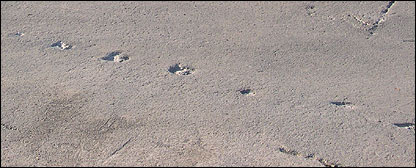The first humans who came to America left their footprints in the hardened sand

Humans arrived in America about 30 years earlier than previously thought. This is according to new findings. A team of scientists reached this controversial conclusion by dating human footprints preserved in volcanic ash in a quarry in Mexico. The scientists say that the first Americans arrived by sea and not on foot.
The traditional estimate is that the first settlers on the continent arrived about 11 thousand years ago by crossing a land bridge between Siberia and Alaska. Details of the findings were published at the Summer Science Conference of the British Royal Society.
An ancient lake
Dr Sylvia Gonzalez of Liverpool John Moores University and her colleagues discovered the footprints in a quarry 130 kilometers southeast of Mexico City in 2003 but only dated them this year.
The footprints were preserved as trace fossils in the volcanic ash that was then the shore of an ancient volcanic lake. They were quickly covered in more ash and lake sediment and as the water level rose, they became hard as concrete. "This is going to be an archaeological time bomb," said Gonzalez.
The team used several methods to date the variety of materials from the site near Puebla, Mexico, in order to ensure the accuracy of the dates.
"We have dating of materials from a layer below the footprint layer, from the footprint layer itself and from a layer above me. Everything works out and seems logical." said Dr. Gonzalez.
The researchers used radioactive carbon dating to date the shells and animal bones in the sequence of layers, and they also dated mammoth teeth using a technique called electron spin resonance. The deposits themselves were dated by optically stimulated luminescence.
"Some of the deposits were incorporated into the ash and baked. They look like small fragments of bricks, and they have been dated to 38 years old," said Gonzalez.
crossing the land
According to the traditional assumption, humans arrived from Siberia to Alaska on foot in the middle of a land bridge that connected the two land masses at the end of the Ice Age (between 10 and 12.5 thousand years before our era). At the center of the theory, called the Clovis model, are Clovis points - sites where tools were found that the settlers used to hunt large animals such as mammoths and mastodons.
"The existence of 40-year-old footprints in Mexico means that the Clovis model of human expansion can no longer be accepted as the first evidence of human presence in the Americas," says David Howard, also from John Moores University in Liverpool and a partner in the study.
Dr. Michael Faught, an expert in the archeology of the first Americans, said that he is waiting to judge the findings until they are published. "It will be impressive and important if indeed it is proven, but usually these ancient sites are not well preserved" he said. However, he added: "There is more and more evidence that Alaska was not the only place through which humans reached the continent."
Dr. Gonzalez supports the theory of marine settlement, according to which humans arrived in boats to the west coast and hugged the coastline from north to south. However, the place of origin of these settlers is still a mystery, she said. Some have suggested that the first humans to arrive in the Americas could have come from Southeast Asia or even Australia. Genetic studies of contemporary Native American populations support the accepted theory that they arrived from Northeast Asia, via the Bering Strait at the end of the last ice age. Dr. Gonzalez hypothesizes that the first settlers became extinct, and therefore did not leave a genetic legacy in our time. She believes that these hunters were extremely mobile, lived in small groups, perhaps this explains why they did not leave much evidence of their presence.
Dr. Gonzalez and DNA expert Alan Cooper from the University of Adelheid in Australia performed a genetic test of the DNA from three molars of the Penion woman (3), a 13-year-old partial skeleton from Mexico. The analysis of the findings has not yet been completed.
